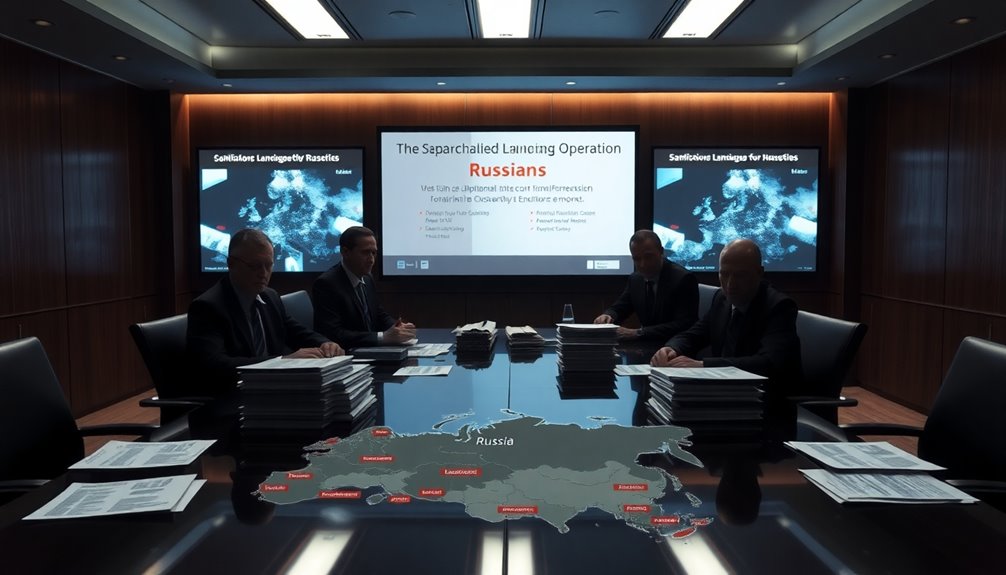You might find it ironic that just as the world was celebrating advancements in cryptocurrency, the U.S. Treasury disclosed a shocking network of five masterminds orchestrating a vast Russian laundering ring. These individuals, like Ekaterina Zhdanova and George Rossi, are employing sophisticated techniques to mask the origins of staggering amounts of illicit funds. Their operations raise critical questions about the effectiveness of current financial regulations and the intricate connection between crime and technology. What's more, their web stretches far beyond borders, hinting at a much larger issue that could affect us all.
Key Takeaways
- Ekaterina Zhdanova leads the Smart network, orchestrating extensive cryptocurrency laundering operations and is under OFAC sanctions since November 2023.
- Close associates Magomedov and Krasnov support Zhdanova's illicit activities, linked to Russian espionage and criminal enterprises, also facing sanctions.
- George Rossi, founder of TGR Partners, coordinates the TGR network, enabling fund transfers for money laundering across various countries.
- Elena Chirkinyan and Andrejs Bradens serve key roles in managing TGR operations and exporting electronics, contributing to the laundering infrastructure.
- U.S. Treasury sanctions target these individuals and entities to disrupt their financial networks and combat transnational crime effectively.
Key Figures in the Networks

In the intricate web of Russian laundering operations, key figures emerge as pivotal players driving the networks' illicit activities. At the forefront is Ekaterina Zhdanova, who led the Smart network and was sanctioned by OFAC in November 2023. She's known for laundering hundreds of millions in cryptocurrency and has close ties with Magomedov and Krasnov, both of whom have also been sanctioned. Their operations not only funded criminal enterprises but also Russian espionage and ransomware groups. The NCA disrupted a multi-billion dollar money laundering network with the involvement of these networks, highlighting the extensive reach of their illicit activities. Furthermore, Operation Destabilise revealed the networks' ability to bypass financial restrictions imposed by the UK.
On the other side, George Rossi, a Ukrainian national, founded TGR Partners and likely controls the TGR Group, while his subordinate, Elena Chirkinyan, manages TGR Corporate Concierge LTD. Both are also under OFAC sanctions. The networks are further intertwined with individuals like Andrejs Bradens, who exports electronics to Russia and operates various companies, and Nikita Vladimirovich Krasnov, who specializes in laundering cash and crypto.
All these players contribute to a complex system that obscures the origin of illicit funds, showcasing how interconnected these networks are in their efforts to evade detection and maintain their operations.
Innovative Money Laundering Techniques

Key figures in Russian laundering operations employ a range of innovative techniques to obscure the illicit origins of their funds. By leveraging technology and complex financial maneuvers, they make it challenging for authorities to trace these transactions.
You'll find some of the most notable methods include:
- Nested services: Using illicit addresses for exchanges through APIs of larger crypto platforms, enabling anonymous transactions via OTC brokers.
- Smurfing: Converting one cryptocurrency into another across different platforms, complicating the tracing process through multiple digital currencies.
- Fake invoices: Generating false documentation that inflates the value of goods, aiding in obscuring the true nature of the transactions.
- Shell company networks: Channeling funds through multiple shell companies, effectively hiding their origins while exploiting various legal loopholes.
These techniques highlight the sophistication of modern money laundering, as they exploit both digital advancements and traditional methods. The estimated 2-5% of global GDP laundered annually emphasizes how critical it is for authorities to enhance their detection and enforcement capabilities. Moreover, the rise of AML/CFT regulations has become essential in combating such advanced laundering tactics. By continuously evolving their strategies, these criminals stay one step ahead, making it imperative for authorities to enhance their detection and enforcement capabilities. Furthermore, the use of specialized software tools can significantly bolster efforts in tracking and analyzing suspicious transactions in the crypto space. As such, the integration of AI technologies is becoming increasingly vital in improving transaction monitoring and risk assessment processes. Additionally, the involvement of shell companies in these operations further complicates the detection process, as they often obscure the true ownership and source of illicit funds. The implementation of continuous evaluation methods for transaction monitoring can help authorities adapt to these evolving challenges.
Global Geographic Reach

The global geographic reach of Russian laundering operations is vast and intricate, involving multiple jurisdictions and sophisticated networks. You'll find Britain as a key operational hub, with activities spreading throughout Europe. Their influence extends into the Middle East and Latin America, where they've established connections that facilitate money movement. Significantly, their involvement with the Irish Kinahan drug cartel based in Dubai highlights the diverse reach of these operations.
The TGR network, led by Ukrainian national George Rossi, mirrors this global footprint. It coordinates closely with the Smart network, enabling seamless fund transfers across various countries. They exploit intermediary jurisdictions to build complex networks, often utilizing shell and front companies in offshore financial centers. Non-resident bank accounts in secrecy jurisdictions further enhance their anonymity. Additionally, the use of alternative financial channels like cryptocurrencies allows for rapid, cross-border transactions. Money laundering networks have also been known to utilize sophisticated methods to obscure financial transactions. Furthermore, recent publications highlight advancements in mine action that emphasize sustainable development outcomes. Trade-based money laundering techniques complement these efforts, complicating detection. As authorities ramp up enforcement, these networks face increasing scrutiny, but their intricate web makes them difficult to dismantle.
Connections to Other Crimes

Amidst the shadows of global crime networks, connections between mercenarism and various illicit activities become increasingly apparent. You'll see that mercenaries don't operate in isolation; they're deeply intertwined with other forms of transnational crime. The financial methods they use often overlap with those employed by drug traffickers, human smugglers, and arms dealers.
Consider these links:
- Smuggling and banditry thrive during ceasefires, creating opportunities for mercenaries to exploit chaos.
- Natural resource exploitation, like gold and petroleum, fuels mercenarism, intertwining their fates with illegal resource extraction.
- Online frauds and scams generate additional funds, showcasing the adaptability of these networks.
- Complex financial routes used by mercenaries mirror those of other criminal enterprises, facilitating collaboration and resource sharing. Additionally, these networks often engage in illegal procurement activities that pose significant risks to national security.
These connections reveal a disturbing ecosystem where mercenaries not only finance their operations through crime but also contribute to a broader landscape of organized crime. Understanding these overlaps is essential for dismantling the financial networks that sustain these threats, highlighting the urgent need for targeted interventions.
Impact of Sanctions and Legal Actions

Sanctions and legal actions have become powerful tools in the fight against transnational crime and mercenarism, particularly in the context of Russian networks. The U.S. Treasury's Office of Foreign Assets Control (OFAC) recently sanctioned five individuals and four entities linked to the TGR Group for facilitating sanctions evasion. This network exploits digital assets, especially U.S. dollar-backed stablecoins, to bypass international controls. Additionally, the TGR Group is known for its money laundering activities, which further complicates the landscape of financial crime. The coordinated efforts of the UK and U.S. not only aim to disrupt these networks but also expose billion-dollar operations that have previously evaded law enforcement. Furthermore, these sanctions are part of a broader strategy to isolate the Russian economy, limiting its access to global financial systems. In this context, the recent OFAC sanctions against 16 entities and individuals linked to Russian interference underscore the seriousness of these efforts. Moreover, the U.S. Mint's oversight of coin production ensures that financial resources remain tightly controlled amid these sanctions.
Financial institutions face serious repercussions if they facilitate transactions with these sanctioned parties. With updated Executive Orders, foreign banks can experience blocking sanctions and restrictions on their U.S. correspondent accounts. This pressure forces them to enhance internal controls to prevent unintentional sanctions circumvention.
Globally, the U.S. collaborates with allies like the UK and UAE to dismantle these networks, as seen in Operation Destabilise, which led to numerous arrests and significant asset seizures. The sanctions effectively isolate the Russian economy, limiting its access to global financial systems and curtailing revenues from various sectors.
Ultimately, these coordinated efforts aim to restrict Russia's ability to procure military resources and support its military-industrial base, marking significant strides in the fight against financial crime.
Conclusion
As the U.S. Treasury exposes the dark underbelly of this laundering ring, the stark contrast between their cunning strategies and the vigilance of law enforcement becomes apparent. While Ekaterina Zhdanova and George Rossi craft intricate financial webs to hide their illicit gains, the global community rallies to strip away their disguises. This battle between innovation in crime and the relentless pursuit of justice underscores an essential truth: in the shadows of finance, cooperation is the light that breaks through.









